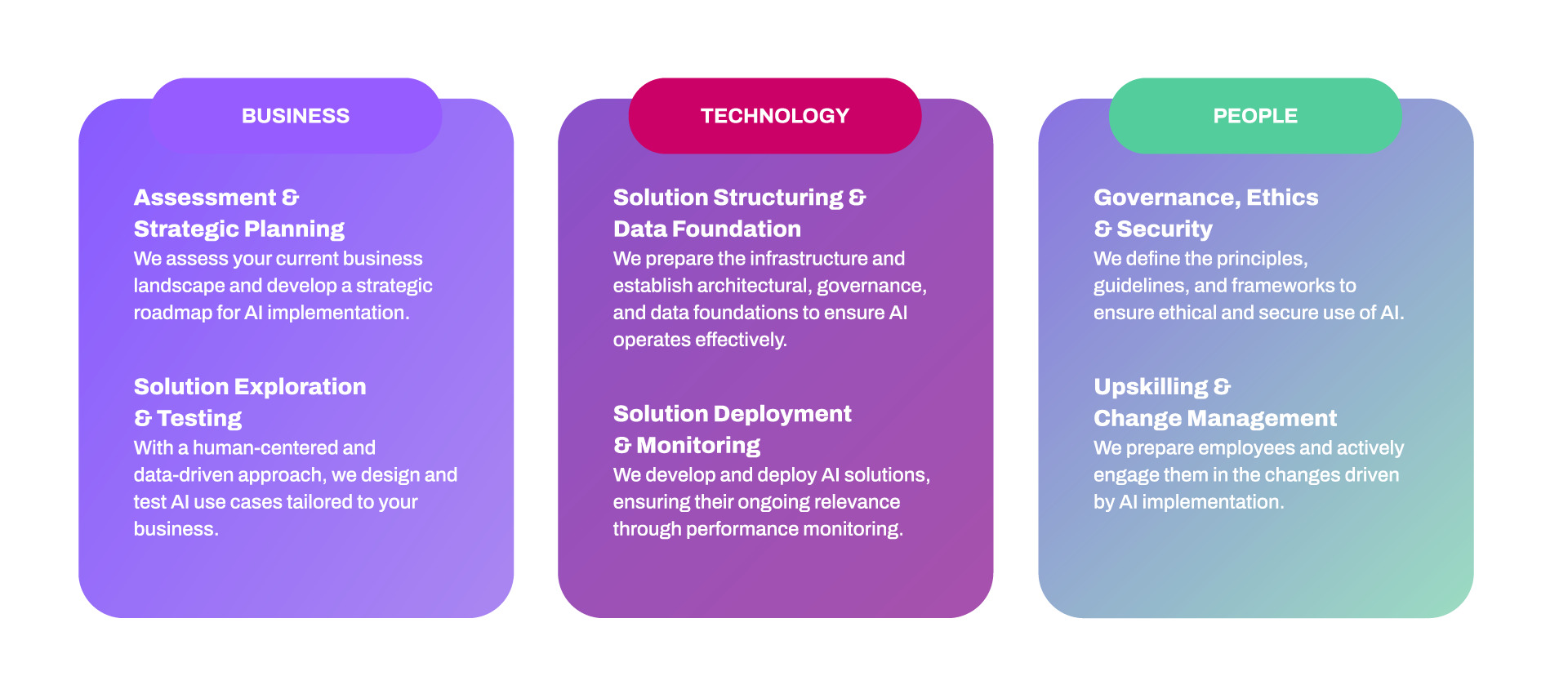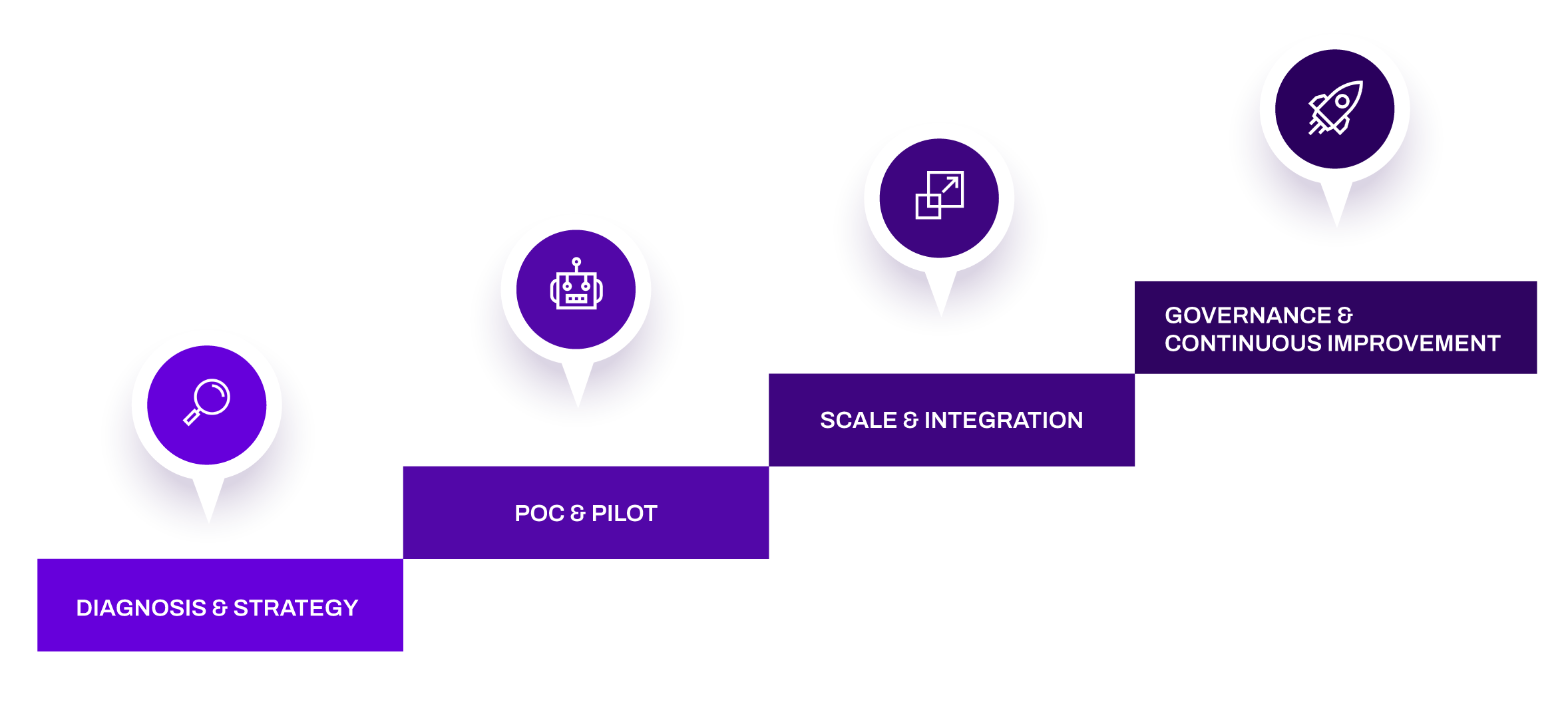AI Transformation is Here. Is Your Company Ready for the Future?
AI Transformation goes beyond adopting new tools — it’s a complete reinvention of data, technology, and culture to build smarter, more agile, and future-ready enterprises.
Artificial Intelligence (AI) is rapidly becoming the new engine of the digital economy. For senior leaders today, understanding and driving AI Transformation is no longer optional. It is essential to stay competitive, respond to market shifts, and unlock entirely new business models.
True AI Transformation isn’t about simply plugging in a new tool; it’s about fundamentally rewiring your company’s DNA to operate with predictive power, greater efficiency, and a deep, data-driven understanding of your customers.
The numbers don’t lie. According to recent research, by 2030 AI is projected to contribute more than $15 trillion to the global economy. The question isn’t if this shift will impact your industry, but how profoundly—and whether your organization will lead the charge or struggle to keep up.
At the end of the day, every leader must ask:
Are you simply using AI, or are you building a truly intelligent enterprise?
What is AI Transformation, Really?
AI Transformation is a complete reinvention that infuses intelligence into every facet of your organization—from supply chain logistics and financial modeling to marketing personalization and product innovation. It requires a seismic shift in three core areas: your data, your technology, and—most importantly—your people.
This shift demands a redesign of how work gets done, how decisions are made, and how value is created.
Unlike digital transformation, which often focuses on digitizing existing processes (for example, moving from paper to cloud), AI Transformation uses data and algorithms to make those processes intelligent, predictive, and autonomous. It’s the difference between an electronic ledger and a predictive financial model that can forecast market shifts.
At its core, AI Transformation is not just a technological upgrade—it’s a fundamental cultural and operational change.
Why AI Transformation Matters
- Strategic Agility: Companies equipped with AI can anticipate trends, simulate scenarios, and react faster than competitors.
- Market Disruption: AI enables personalization at scale, creating new customer segments and revenue streams.
- Efficiency with Leverage: Beyond operational efficiency, AI offers predictive decision-making—transforming reactive operations into proactive, strategic actions.
💡Industry surveys suggest that more than 90% of executives intend to boost AI budgets within the next three years, and 55% expect to raise them by double-digit percentages.
Benefits of AI Transformation

The rewards of a successful AI Transformation extend far beyond cost savings and efficiency. While automating routine tasks is valuable, the true impact lies in creating new forms of competitive advantage.
- New Revenue Streams: AI can analyze market trends and consumer data to identify unmet needs, paving the way for innovative products and services.
- Personalization at Scale: AI enables businesses to deliver highly tailored experiences. From e-commerce recommendations pioneered by Amazon to customized marketing campaigns, AI makes every customer feel uniquely understood.
- Predictive Decision-Making: Instead of reacting to the past, AI allows organizations to anticipate future outcomes. AI-powered analytics can forecast demand, predict customer churn, and flag risks before they materialize. In retail, AI-driven demand forecasting has reduced stock-outs by up to 40%.
- Market Disruption: By leveraging data-driven insights, companies can redefine industries. From AI-powered fraud detection in finance to algorithmic trading, AI enables new business models that deliver superior value to customers.
💡 “AI is projected to add $22.3 trillion to the global economy by 2030—nearly 3.7% of global GDP.”
3 Pillars of a Truly Intelligent Enterprise

A successful AI Transformation rests on three interconnected pillars. Neglecting any one of them can undermine the entire initiative. At MJV, we view these pillars not as isolated silos but as interdependent components of a single, human-centered strategy.
Pillar 1: Data — The Fuel for Your Engine
Data is the lifeblood of AI. Without high-quality, accessible data, even the most advanced algorithms are useless. A strong data foundation requires:
- Quality: Accurate, complete, and consistent data.
- Governance: Clear policies for data management, security, and privacy.
- Accessibility: Breaking down silos so data flows freely—and securely—to the teams and systems that need it.
Pillar 2: Technology — The Engine Itself
The right technology stack is crucial for building, deploying, and managing AI models at scale. Key components include:
- Cloud Infrastructure: Scalable compute power and storage for data-intensive workloads.
- MLOps (Machine Learning Operations): Automation and discipline for managing the end-to-end lifecycle of AI models.
- Automation Platforms: Streamlined workflows that embed AI insights into daily operations.
Pillar 3: People & Culture — The Driver at the Wheel
Technology alone does not drive transformation—people do. This is the most critical, and often the most challenging, pillar. It involves:
- Upskilling & Reskilling: Training employees with AI literacy and practical skills to thrive.
- Fostering a Growth Mindset: Encouraging curiosity, experimentation, and learning from failure.
- Cross-Team Collaboration: Aligning data scientists, business analysts, and domain experts to ensure AI supports strategic goals.
- Human-Centered Design: Building AI to augment and enhance human capabilities, not replace them.
At MJV, our experience with FMCG clients and major financial institutions shows that success depends on putting people at the center. Our Human-Centered AI Transformation Framework focuses on how transformation impacts behaviors, motivations, and daily workflows—ensuring buy-in and driving deep, lasting adoption.
Phases of AI Transformation Implementation

MJV’s structured journey includes the following stages:
Stage One: Diagnosis & Strategy
The first step is to understand where you are and where you want to go. This involves:
- Assessment: Evaluating your company’s AI maturity across the three pillars: data, technology, and people.
- Alignment: Identifying high-impact business problems that AI can solve and aligning your AI strategy with your overarching business goals.
- Prioritization: identify and prioritize high-impact use cases.
Stage Two: Proof of Concept (PoC) & Pilot
With a clear strategy in place, the focus shifts to experimentation and delivering tangible results.
- Experimentation: Start small with a well-defined PoC to test a hypothesis and demonstrate the value of AI.
- Measurable Wins: A successful pilot should deliver a clear, measurable business outcome, building credibility and securing buy-in for broader initiatives.
Stage Three: Scale & Integration
Once a pilot has proven its value, the challenge is to scale the solution across the enterprise. This requires:
- Enterprise-Wide Adoption: Developing the infrastructure, processes, and governance to deploy and manage AI solutions at scale.
- Integration: Embedding AI into core business processes and decision-making workflows.
- Embed Agile methodologies for continuous evolution.
Stage Four: Governance & Continuous Improvement
AI is not a one-time project. Models need to be monitored, retrained, and refined as data and business conditions change.
- Ethics and Compliance: Establish clear ethical guidelines and ensure compliance with regulations.
- Iteration: Create a feedback loop for continuous improvement, ensuring that your AI capabilities evolve and adapt over time.
This is where structured roadmaps and partner expertise matter most. Guiding an organization through these phases requires a blend of technical expertise, strategic foresight, and a deep understanding of change management.
Simple Automation vs. AI
Automation (e.g., RPA) replicates human rules for efficiency. True AI, however, learns patterns, adapts in real time, and reasons—creating exponential value. An AI-driven chatbot, for instance, can anticipate customer needs, not just execute scripted replies.
Real-World Examples of MJV’s AI Transformation
Modernizing Quality Control at GSK
In the pharmaceutical industry, efficiency in Quality Control (QC) is critical to reducing vaccine delivery times. For GSK, traditional processes were fragmented across global teams, slowing decision-making and limiting visibility.
- The Challenge:
- Unify QC operations across 100+ teams, 10 labs, and 6 languages, while reducing bottlenecks in global vaccine production.
- The AI Solution:
- MJV designed and implemented an AI-driven Smart QC platform, supported by a tailored change management strategy. This included cross-cultural engagement, standardized training, and a governance model to ensure adoption across 900+ employees worldwide.
- The Result:
- GSK achieved significant productivity gains, enhanced process visibility, and accelerated global decision-making. The initiative became a global model for transformation within GSK, setting the stage for faster and more reliable vaccine delivery.
Reinventing Finance with Intelligent Defense
In the financial sector, risk is a constant. For one of the world’s largest banks, manually filtering fraudulent account applications was slow, costly, and prone to error.
- The Challenge:
- Create an automated, intelligent first line of defense to catch fraud before it impacts the business.
- The AI Solution:
- MJV developed a machine learning model that analyzes application data in real-time. The model was trained to identify complex patterns indicative of fraud that are invisible to the human eye.
- The Result:
- The model achieved a 74% fraud detection rate, automatically approving, denying, or flagging applications for review. This dramatically reduced the workload on the fraud analysis team and significantly improved the accuracy of their detection efforts, saving the company from substantial potential losses.
Challenges of AI Transformation

Senior leaders must anticipate hurdles like:
- Data silos & quality issues
- Cultural resistance and lack of AI literacy
- Scaling complexity from pilot to enterprise
- Ethical, security, and governance risks
However, these challenges are not insurmountable. With a clear vision, strong leadership commitment, and the right strategic partner, like MJV, to guide the way, any organization can navigate this complex terrain.
Essential Tools & Platforms
Successful AI Transformation relies on:
- Cloud AI Services: Scalable compute and model hosting.
- MLOps Tools: Model lifecycle, versioning, and CI/CD for AI.
- Analytics Platforms: Descriptive, predictive, and prescriptive tools.
- Governance Frameworks & Data Infrastructure: Ensuring security, ethics, and compliance.
Choosing the right tools is important, but it’s secondary to the strategy. At MJV, we remain tech-agnostic. Our primary focus is on understanding your unique business challenges and then architecting the best solution to drive maximum impact, regardless of the platform.
Getting Started: Your AI Transformation Journey
AI Transformation isn’t a project with an endpoint—it’s a continuous evolution. Here’s how to begin:
- Run a fast AI readiness assessment
- Align executive sponsors & build cross-functional teams
- Design one or two high-impact PoCs
- Engage employees via training, workshops, and change champions
- Establish monitoring, governance, and iteration routines
- Scale strategically based on measured impact
Conclusion
AI Transformation is a strategic imperative for any organization striving to stay competitive, innovative, and adaptive in today’s rapidly shifting markets. With the right mindset, structured approach, and human-centered design, your company can leverage AI not just for efficiency—but for reinvention.
Ready to begin? Explore how MJV can guide you—from diagnostics and pilot programs to scaling AI across your business. Let’s craft your AI Transformation roadmap together.
→ Discover MJV’s AI Transformation services today

